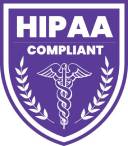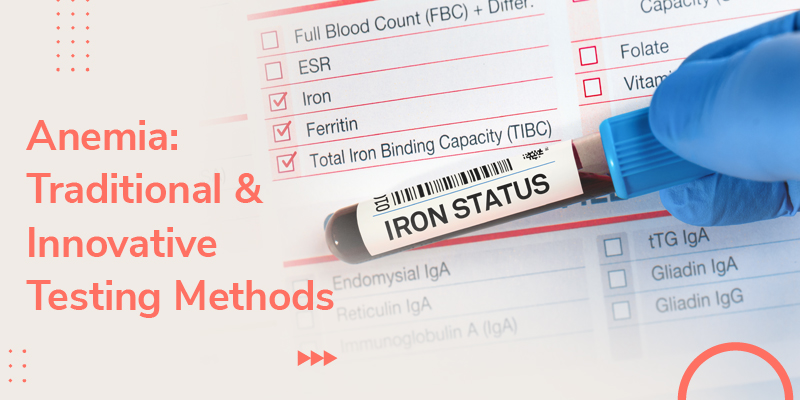
Anemia: Traditional & Innovative Testing Methods
Anemia Detection: The Earlier The Better
Anemia is one of the serious health issues among women of reproductive age and children below five years. Screening of anemic patients before the condition progresses can save many lives.
However, traditional testing methods require specific chemicals, machines, and devices. It also requires the presence of nurses, laboratory workers, and doctors. Moreover, these methods are costly, time-consuming, and produce biohazard waste. A reliable healthcare platform like REAN Foundation will help you keep a check on your health status from the comfort of your home.
The solution is to use non-invasive methods for hemoglobin estimation to provide a point of care diagnosis. Options like telemedicine will save time and money while assisting in continuous blood hemoglobin monitoring. However, there is a big challenge. All the testing methods developed so far have specific device requirements. These devices may not be accessible or difficult to operate by common people for self-assessment.
Our article looks at the types of anemia testing methods that are user-friendly and do not require comprehensive laboratory infrastructure or trained personnel. But before we delve into the core topic, let's first understand the disease Anemia.
What Is Anemia & Why Does It Occur?
According to WHO, "Anemia is a condition in which the number or size of red blood cells, or the hemoglobin concentration, falls below an established cut-off value. As a result, it impairs the capacity of the blood to transport oxygen around the body.
The estimation values differ with gender, age group, and pregnancy condition, and the level of hemoglobin also tells the severity of anemia.
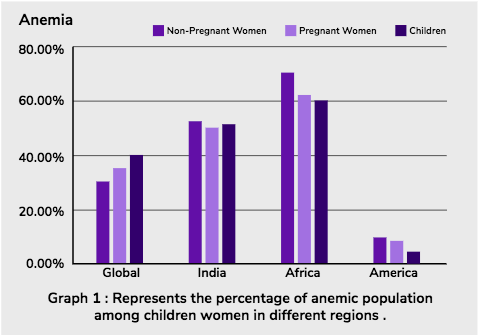
Iron deficiency in the body can:
- Limit the oxygen transport in the body
- Reduce your physical and mental capacity
- Increase the maternal mortality rate
- Cause stillbirths miscarriages among pregnant women
- Cause low birth weight
- Increase the infant mortality rate
- Reduce the physical and mental performance of children
Global statistics of Anemia
Anemia is a serious condition worldwide. About 40% of pregnant women and 42% of children worldwide are anemic. Conditions are more severe in South Asia, Central, and West Africa. In India, 53% of women of reproductive age and 54 % of children aged 6 months to 5 years are anemic.
Detailed regional data is graphically represented here:
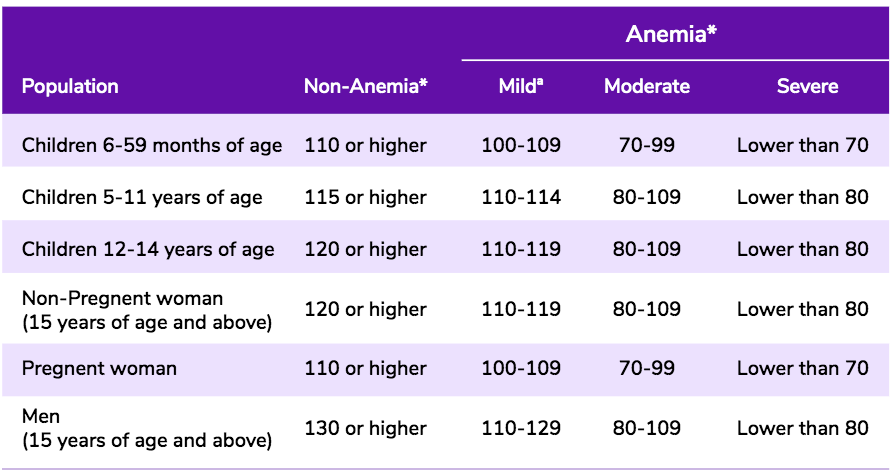
The World Health Organization (WHO) aims to reduce Anemia by 50% among women of reproductive age as per Global Nutrition target 2025. To achieve this target cost, effective screening is required. If anemia is identified at its mild or moderate stage, severe anemic conditions can be avoided.
The table gives the detailed level of hemoglobin for the Anemia and Non-Anemia population among different age groups and severity of Anemia according to the level of hemoglobin.
So, how is anemia detected in today's world of modern medical sciences? Health experts rely on various traditional, invasive, and non-invasive tests to detect Anemia. With the enormous advancements in medical sciences, more innovative methods have been developed for Anemia detection.
Also Read: Tech Platforms: Empowering Government Health Programs
Anemia Detection: From Traditional To Innovative Testing Methods
Traditional Testing
The most commonly used methods for hemoglobin testing are:
- Sahil's test
- Hemiglobincyanide Method
- Vanzetti’s Azide Methemoglobin
- Reagent-less Method.
These methods are costly, time-consuming, require specific chemicals and equipment, and have many disadvantages. Most importantly, the chemicals used in these tests are bio-hazardous and pollute the environment.

Table 2: different methods available in market chemical or resources required for those methods time for the procedure and cost of the test.
Physical Examination
Four levels of physical examination are used to confirm anemia in a patient. These include:
- Color tint of the lower eyelid conjunctiva
- Nail-bed rubor
- Nail-bed blanching
- Palmar crease rubor
The color tint of these regions doesn't depend on a person's skin color due to the absence of melanocytes (melanin-producing cells).
Conjunctival pallor presence can be directly correlated with the condition of Anemia and the determination of hemoglobin level. Physical examinations done by doctors are subjective. Hence, the results could be less accurate.
Non-invasive Methods
Invasive methods are painful, risky, costly, and time-consuming. They also require experts to take samples and perform the estimation technique. Therefore, modern technology implementation and development of non-invasive methods are needed of the hour.
Some non-invasive testing methods have gained researchers' attention in the last decade.
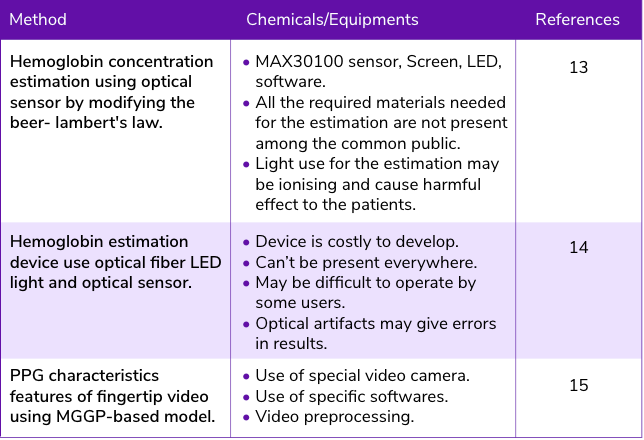
Table 3: Different non-invasive methods developed recently and problems associated with them.
Machine Learning Use for Other Diseases
Machine Learning (ML) and other deep learning models have been developed for disease diagnosis in recent years. The images derived from these technologies include:
- X-ray
- MRI
- PET scan
- ECG
- EMG graphs signals
Given below are some examples:
- OCT images to identify muscular edema- an early sign of blindness, cancer, and other diseases.
- Methylation pattern detection algorithm to detect ct-DNA in blood plasma
- Chest x-rays for the detection of viral, non-viral, and Covid-19 pneumonia
- The retinal fundus images to detect CHD (Congenital Heart Disease ) in the fetus, Type 2 diabetes, and kidney diseases.
Penetration of Smartphones in Public
Smartphones play an important part in the lives of young and older generations. According to the ICT report 2020, 80% of the world population is accessible to mobile phones, and 51% of the global population can access the internet.
Situations like Covid-19 have taught us how the healthcare sector can function without physical interaction for small health problems. Smartphones can take pictures of the eye conjunctiva region and nail bed region. Using these images, feature extraction can be done with Machine Learning algorithms, which can be directly related to hemoglobin levels in the body.
All the past studies and models are detailed in Table 4.

The Novelty Of REAN Foundation's Study
REAN Foundation is developing an algorithm using the images of four regions: conjunctiva, nail bed, palm crease, and tongue. The combined region algorithm will be more accurate and reliable.
Plan of Action
The plan we will follow for developing the feature is in figure 1.
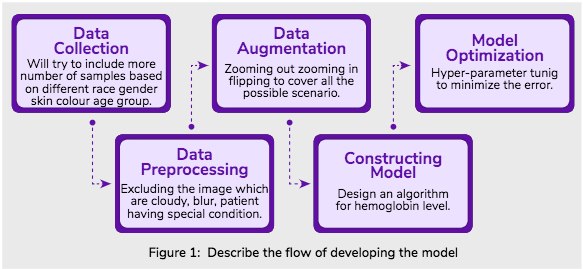
Benefits of REAN HealthGuru app:
- Non-invasive
- Low cost
- Accessible
- Quick
This application is based on advanced machine learning and deep learning algorithms.
It can be used for home healthcare to self-diagnose hemoglobin levels and determine what kind of food to include in the diet. The app also indicates the addition of supplements to the diet to keep the hemoglobin level at the optimum level. Even doctors can use the application during OPD screening as the physical examination may have subjective bias. REAN Foundation's HealthGuru app can help healthcare workers with point-of-care treatment and early disease diagnosis.
Anemia Detection: The Earlier The Better
Anemia is one of the serious health issues among women of reproductive age and children below five years. Screening of anemic patients before the condition progresses can save many lives.
However, traditional testing methods require specific chemicals, machines, and devices. It also requires the presence of nurses, laboratory workers, and doctors. Moreover, these methods are costly, time-consuming, and produce biohazard waste. A reliable healthcare platform like REAN Foundation will help you keep a check on your health status from the comfort of your home.
The solution is to use non-invasive methods for hemoglobin estimation to provide a point of care diagnosis. Options like telemedicine will save time and money while assisting in continuous blood hemoglobin monitoring. However, there is a big challenge. All the testing methods developed so far have specific device requirements. These devices may not be accessible or difficult to operate by common people for self-assessment.
Our article looks at the types of anemia testing methods that are user-friendly and do not require comprehensive laboratory infrastructure or trained personnel. But before we delve into the core topic, let's first understand the disease Anemia.
What Is Anemia & Why Does It Occur?
According to WHO, "Anemia is a condition in which the number or size of red blood cells, or the hemoglobin concentration, falls below an established cut-off value. As a result, it impairs the capacity of the blood to transport oxygen around the body.
The estimation values differ with gender, age group, and pregnancy condition, and the level of hemoglobin also tells the severity of anemia.

Iron deficiency in the body can:
- Limit the oxygen transport in the body
- Reduce your physical and mental capacity
- Increase the maternal mortality rate
- Cause stillbirths miscarriages among pregnant women
- Cause low birth weight
- Increase the infant mortality rate
- Reduce the physical and mental performance of children
Global statistics of Anemia
Anemia is a serious condition worldwide. About 40% of pregnant women and 42% of children worldwide are anemic. Conditions are more severe in South Asia, Central, and West Africa. In India, 53% of women of reproductive age and 54 % of children aged 6 months to 5 years are anemic.
Detailed regional data is graphically represented here:

The World Health Organization (WHO) aims to reduce Anemia by 50% among women of reproductive age as per Global Nutrition target 2025. To achieve this target cost, effective screening is required. If anemia is identified at its mild or moderate stage, severe anemic conditions can be avoided.
The table gives the detailed level of hemoglobin for the Anemia and Non-Anemia population among different age groups and severity of Anemia according to the level of hemoglobin.
So, how is anemia detected in today's world of modern medical sciences? Health experts rely on various traditional, invasive, and non-invasive tests to detect Anemia. With the enormous advancements in medical sciences, more innovative methods have been developed for Anemia detection.
Also Read: Tech Platforms: Empowering Government Health Programs
Anemia Detection: From Traditional To Innovative Testing Methods
Traditional Testing
The most commonly used methods for hemoglobin testing are:
- Sahil's test
- Hemiglobincyanide Method
- Vanzetti’s Azide Methemoglobin
- Reagent-less Method.
These methods are costly, time-consuming, require specific chemicals and equipment, and have many disadvantages. Most importantly, the chemicals used in these tests are bio-hazardous and pollute the environment.

Table 2: different methods available in market chemical or resources required for those methods time for the procedure and cost of the test.
Physical Examination
Four levels of physical examination are used to confirm anemia in a patient. These include:
- Color tint of the lower eyelid conjunctiva
- Nail-bed rubor
- Nail-bed blanching
- Palmar crease rubor
The color tint of these regions doesn't depend on a person's skin color due to the absence of melanocytes (melanin-producing cells).
Conjunctival pallor presence can be directly correlated with the condition of Anemia and the determination of hemoglobin level. Physical examinations done by doctors are subjective. Hence, the results could be less accurate.
Non-invasive Methods
Invasive methods are painful, risky, costly, and time-consuming. They also require experts to take samples and perform the estimation technique. Therefore, modern technology implementation and development of non-invasive methods are needed of the hour.
Some non-invasive testing methods have gained researchers' attention in the last decade.

Table 3: Different non-invasive methods developed recently and problems associated with them.
Machine Learning Use for Other Diseases
Machine Learning (ML) and other deep learning models have been developed for disease diagnosis in recent years. The images derived from these technologies include:
- X-ray
- MRI
- PET scan
- ECG
- EMG graphs signals
Given below are some examples:
- OCT images to identify muscular edema- an early sign of blindness, cancer, and other diseases.
- Methylation pattern detection algorithm to detect ct-DNA in blood plasma
- Chest x-rays for the detection of viral, non-viral, and Covid-19 pneumonia
- The retinal fundus images to detect CHD (Congenital Heart Disease ) in the fetus, Type 2 diabetes, and kidney diseases.
Penetration of Smartphones in Public
Smartphones play an important part in the lives of young and older generations. According to the ICT report 2020, 80% of the world population is accessible to mobile phones, and 51% of the global population can access the internet.
Situations like Covid-19 have taught us how the healthcare sector can function without physical interaction for small health problems. Smartphones can take pictures of the eye conjunctiva region and nail bed region. Using these images, feature extraction can be done with Machine Learning algorithms, which can be directly related to hemoglobin levels in the body.
All the past studies and models are detailed in Table 4.

The Novelty Of REAN Foundation's Study
REAN Foundation is developing an algorithm using the images of four regions: conjunctiva, nail bed, palm crease, and tongue. The combined region algorithm will be more accurate and reliable.
Plan of Action
The plan we will follow for developing the feature is in figure 1.

Benefits of REAN HealthGuru app:
- Non-invasive
- Low cost
- Accessible
- Quick
This application is based on advanced machine learning and deep learning algorithms.
It can be used for home healthcare to self-diagnose hemoglobin levels and determine what kind of food to include in the diet. The app also indicates the addition of supplements to the diet to keep the hemoglobin level at the optimum level. Even doctors can use the application during OPD screening as the physical examination may have subjective bias. REAN Foundation's HealthGuru app can help healthcare workers with point-of-care treatment and early disease diagnosis.

